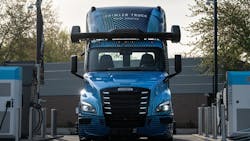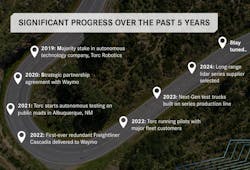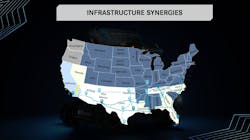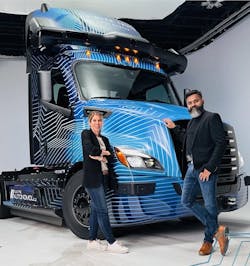Daimler sets out to demonstrate how autonomous EVs could change trucking
Trucking’s future fuel solutions are uncertain as the industry grapples with decarbonization pushes and unproven solutions. But Daimler Truck North America knows that no matter what will power trucking in the coming years, the U.S. freight industry will still need trucks—with or without humans behind the wheels—hauling freight-filled trailers.
The maker of Freightliner trucks now has an autonomous eCascadia daycab equipped with Torc Robotics’ self-driving technology and Level 4 autonomous sensors and computing power. The OEM showed off the autonomous eCascadia, which it called a demonstrator, during a virtual media presentation Tuesday broadcast from its North American headquarters in Portland, Oregon.
Torc Robotics, an independent Daimler Truck subsidiary, plans to roll out its diesel-powered AV product to fleets in 2027. The new EV-AV demonstrator will complement the traditional Freightliner Cascadia long-haul sleeper tractors packed with autonomous technology and open up a path for Daimler to adapt its Torc technology on future powertrains.
“We stated that we are focused on how to have long-haul trucking in a diesel configuration at first launch; however, that never stops us from looking ahead at what is coming next,” Joanna Buttler, Daimler Truck’s head of global autonomous technology, said on Tuesday. “We asked ourselves what it would look like if we would combine the freight efficiency potential of autonomous trucks with the promise of zero emissions and decarbonization with our series production of electric vehicles.”
See also: A new kind of fueling system helps scale H2 infrastructure
Daimler demonstrates autonomous potential
Buttler said they are starting this ZE-AV combo with a battery-electric eCascadia but envision the same technology fitting in with potential hydrogen fuel cell EVs and hydrogen internal combustion engine tractors should those technologies become more prevalent. For now, the OEM’s biggest EV in the U.S. will demonstrate how autonomous technology can work on its flagship electric truck.
Daimler is the first legacy North American truck OEM to attach autonomous technology to one of its Class 8 EVs. Torc rival Kodiak Robotics, which is pursuing an OEM-agnostic approach to its self-driving freight product, first featured an all-electric autonomous Class 8 truck a year ago. The AV company upfitted a Peterbilt Model 579EV it showed off at the Advanced Clean Transportation Expo in 2023. Autonomous technology provider Aurora also has North American partnerships with Volvo Trucks and Paccar’s Kenworth and Peterbilt.
Daimler Truck plans to show off its demonstration EV-AV at this year’s ACT Expo later this month. Since 2022, more than 55 U.S. fleets have integrated eCascadias into their operations, logging more than 6 million miles, according to DTNA.
The company considers its demonstration autonomous EV a research and advanced engineering project with the potential to evolve into a modular, scalable platform that is propulsion-agnostic for flexible use in different trucking applications.
See also: The humanless difference: Autonomous efficiency goes beyond fuel savings
Autonomous trucking is already proving to be more fuel-efficient than human-controlled trucks. Some other AV companies have noted fuel savings of up to 17% in testing, which is happening across much of Texas and the Southwest.
“By combining zero-emission and autonomous technologies in one product, we are testing solutions for challenges our customers are likely to face in the future,” John O’Leary, DTNA president and CEO, said this week. “We want to give them choices that allow them to do what they do best: Keep the world moving today and well into the future.”
Searching for ZE-AV synergies
In advance of its 2027 rollout, diesel-powered Freightliner Cascadias with Torc’s AV technology is in tests between Phoenix and Oklahoma City, hauling freight for FleetOwner 500 fleets such as Schneider and C.R. England. Daimler expects autonomous trucking to generate more than $3 billion in revenue as early as 2030.
While the current Torc-driven Cascadias are working on long-haul, hub-to-hub freight movement, Buttler said that the autonomous eCascadia would be more applicable for shorter, repeatable routes based around charging infrastructure.
Buttler said that Daimler hopes to find synergies between ZE and AV infrastructure. She said that the company is already studying what routes and locations would suit both needs, and the future could include combining charging infrastructure with autonomous freight hubs so an electric AV could be charged while it’s loaded and unloaded.
See also: What are EV truck charging stations’ needs?
Truck charging venture Greenlane, created by DTNA, NextEra Energy Resources, and Blackrock, is building out infrastructure in California with plans to expand west toward Texas and the Northeast.
Greenlane aims to develop a nationwide network of commercial charging and hydrogen infrastructure locations across the U.S. The charging sites will also serve battery-electric passenger car and light-duty fleet customers and are designed to provide hydrogen refueling for commercial vehicles in the coming years.
Suman Narayanan, DTNA’s chief vehicle engineer for autonomous driving, said that the autonomous eCascadia demonstrator will help set up Daimler Truck for any future propulsion technology.
“If you think of fuel cell from the propulsion side—not the energy storage—there are a lot of similarities to battery-electric vehicles,” he explained. “This will help us understand what it takes to make that transition to a hydrogen fuel cell when the time is right. And there already exists knowledge on an internal combustion engine—currently diesel-propelled—that will help us should we go and explore the path of hydrogen in an internal combustion engine.”
About the Author
Josh Fisher
Editor-in-Chief
Editor-in-Chief Josh Fisher has been with FleetOwner since 2017. He covers everything from modern fleet management to operational efficiency, artificial intelligence, autonomous trucking, alternative fuels and powertrains, regulations, and emerging transportation technology. Based in Maryland, he writes the Lane Shift Ahead column about the changing North American transportation landscape.




